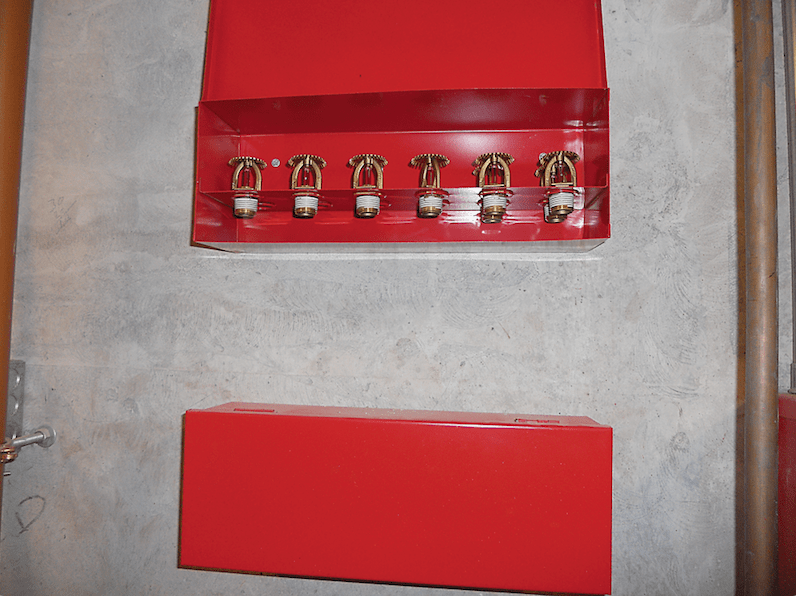By Brian O’Connor P.E., Fire Protection Engineer, NFPA
If you manage a facility, you may sometimes wonder why you have a stock of spare sprinklers. In fact, there are a number of reasons to have them. There are also specific things you should see when you open your sprinkler cabinet, as well as specific instances when you need to use the spare sprinklers.
If you have a sprinkler system installed, then according to NFPA 13, Standard for the Installation of Sprinkler Systems, you are required to have a stock of spare sprinklers. A sprinkler needs to be replaced when it has operated due to a fire, because of accidental discharge, or if the sprinkler itself is painted, damaged, or otherwise impaired. Having spare sprinklers on hand means the replacement can be done without substantial delay, minimizing the time the system is out of service.

When you open your spare sprinkler cabinet, you should of course see some spare sprinklers. The types and number of sprinklers you need depends on the types of sprinklers used and the size of your system. If you have less than 300 sprinklers installed in your facility, then you need at least six spare sprinklers. If you have anywhere between 300 and 1000 sprinklers installed, you need at least 12 spares, and if you have more than 1000 sprinklers installed you need at least 24 spares. If you have different types of sprinklers installed, your cabinet should include at least two spare sprinklers of each type. When you inventory your sprinklers to find out how many and what type you have installed, that information is required to be posted in the sprinkler cabinet.
As many of us have learned, you really do need the right tool for the right job, which is why NFPA 13 also requires a sprinkler wrench to be stored in the cabinet. Using other tools besides the sprinkler wrench can further damage the sprinkler being removed or damage the new sprinkler being installed. Teflon tape should also be kept nearby.
NFPA 13 requires the sprinkler cabinet to be located on the premises so that it can be accessed in a timely manner, and in an area that doesn’t exceed the maximum ceiling temperature allowed for those sprinklers, which is 100°F for ordinary sprinklers.
Knowing when to use these resources is just as important as knowing what you should have. There are several reasons that you need to replace a sprinkler. If the sprinkler is installed in the wrong orientation, such as an upright sprinkler installed in a pendent orientation, you need to replace it. Any leaking sprinkler needs to be replaced. A little bit of corrosion on a sprinkler is acceptable, but when the corrosion is detrimental to sprinkler performance then it needs to be replaced. Any sort of physical damage, including bent and cracked frame arms, means a sprinkler should be replaced. If enough dust, dirt, or grease, or any other type of loading that is detrimental to sprinkler performance, has built up on a sprinkler — and if it can’t be cleaned with a blast of compressed air — then the sprinkler should be replaced. If there is paint on the sprinkler, other than that applied by the sprinkler manufacturer, then it needs to be replaced. If the fluid in the glass bulb leaks out, the sprinkler needs replacing — in a fire, the glass would have to fail from the heat before the sprinkler activated. The fluid in the glass bulb can sometimes lose its coloring, but the sprinkler does not need to be replaced for that reason.
After replacing any number of sprinklers, you will need to check the sprinklers for leaks at the system working pressure. If you happen to replace more than 20 sprinklers, you will be required to conduct a full hydrostatic test in accordance with NFPA 13.
Even though NFPA 25, Standard for the Inspection, Testing, and Maintenance of Water-Based Fire Protection Systems, only requires visual inspections to be done on an annual basis, some sprinklers are easily visible from the ground, so when you see something wrong with a sprinkler, don’t wait until your annual inspection to take action. All the tools you need should be nearby, making replacement fast and efficient.
This article appeared in NFPA Journal recently.
 O’Connor is a fire protection engineer at the National Fire Protection Association (NFPA) and vice president for the New England Chapter of the Society of Fire Protection Engineers. A professional engineer registered in the states of Texas and Massachusetts, he earned his Bachelor’s Degree in Mechanical Engineering and is currently pursuing a Master’s Degree in Fire Protection Engineering from the University of Maryland. At the NFPA, O’Connor is the staff liaison to several technical committees covering topics such as aviation, portable extinguishers, water based fire protection, energy storage systems, and health care facilities.
O’Connor is a fire protection engineer at the National Fire Protection Association (NFPA) and vice president for the New England Chapter of the Society of Fire Protection Engineers. A professional engineer registered in the states of Texas and Massachusetts, he earned his Bachelor’s Degree in Mechanical Engineering and is currently pursuing a Master’s Degree in Fire Protection Engineering from the University of Maryland. At the NFPA, O’Connor is the staff liaison to several technical committees covering topics such as aviation, portable extinguishers, water based fire protection, energy storage systems, and health care facilities.



















![[VIDEO] Collect Asset Data at the Speed of Walking a Building](https://facilityexecutive.com/wp-content/uploads/2024/02/maxresdefault-324x160.jpg)